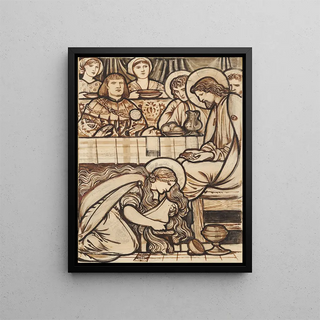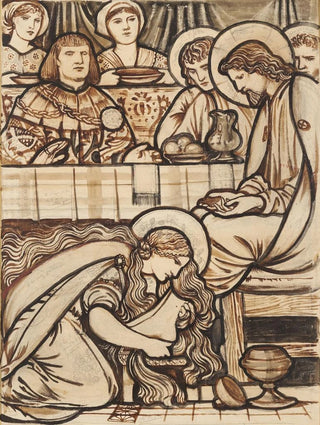Art print | La Madeleine oignant les pieds du Christ - Sir Edward Coley Burne-Jones Source: Reproduction | La Madeleine oignant les pieds du Christ - Sir Edward Coley Burne-Jones


View from behind

Frame (optional)
In the fascinating universe of art, some works transcend time and space, captivating the soul through their emotional depth and aesthetic beauty. The art print of the Magdalene anointing the feet of Christ by Sir Edward Coley Burne-Jones is one of these creations. It evokes a scene filled with devotion and tenderness, where the figure of Mary Magdalene, touching and solemn, bows before Christ. This piece, rich in symbolism, invites the viewer to immerse themselves in a moment of intense spirituality, revealing the complexity of human emotions in the face of divinity. Contemplating this art print transports us into a silent dialogue between humanity and the sacred, a exchange that resonates deeply with our own quest for meaning.
Style and uniqueness of the work
Burne-Jones's style is distinguished by its ability to fuse romanticism with Pre-Raphaelite influences, creating a unique aesthetic that is entirely his own. The art print of the Magdalene anointing the feet of Christ features soft, nuanced colors, elongated forms, and delicate treatment of the faces. The drapery of the garments, fluid and harmonious, almost seems tangible, while the expression of Mary Magdalene, imbued with veneration, captures the very essence of devotion. The composition, skillfully orchestrated, guides the viewer’s gaze toward the tender gesture of the heroine, highlighting the depth of her love and respect. Every detail, from the play of light to delicate shadows, contributes to creating an atmosphere of peace and contemplation, inviting silent and introspective reflection.
The artist and his influence
Sir Edward Coley Burne-Jones, an emblematic figure of the Pre-Raphaelite movement, knew how to mark his era with works imbued with spirituality and romanticism. Born in 1833, he was influenced by the ideals of the Renaissance, seeking to restore to art its sacred and poetic dimension. His innovative approach paved the way for a new understanding of beauty, where each piece becomes an invitation to explore universal themes such as love, suffering, and sacrifice. The art print of the Magdalene

Matte finish

View from behind

Frame (optional)
In the fascinating universe of art, some works transcend time and space, captivating the soul through their emotional depth and aesthetic beauty. The art print of the Magdalene anointing the feet of Christ by Sir Edward Coley Burne-Jones is one of these creations. It evokes a scene filled with devotion and tenderness, where the figure of Mary Magdalene, touching and solemn, bows before Christ. This piece, rich in symbolism, invites the viewer to immerse themselves in a moment of intense spirituality, revealing the complexity of human emotions in the face of divinity. Contemplating this art print transports us into a silent dialogue between humanity and the sacred, a exchange that resonates deeply with our own quest for meaning.
Style and uniqueness of the work
Burne-Jones's style is distinguished by its ability to fuse romanticism with Pre-Raphaelite influences, creating a unique aesthetic that is entirely his own. The art print of the Magdalene anointing the feet of Christ features soft, nuanced colors, elongated forms, and delicate treatment of the faces. The drapery of the garments, fluid and harmonious, almost seems tangible, while the expression of Mary Magdalene, imbued with veneration, captures the very essence of devotion. The composition, skillfully orchestrated, guides the viewer’s gaze toward the tender gesture of the heroine, highlighting the depth of her love and respect. Every detail, from the play of light to delicate shadows, contributes to creating an atmosphere of peace and contemplation, inviting silent and introspective reflection.
The artist and his influence
Sir Edward Coley Burne-Jones, an emblematic figure of the Pre-Raphaelite movement, knew how to mark his era with works imbued with spirituality and romanticism. Born in 1833, he was influenced by the ideals of the Renaissance, seeking to restore to art its sacred and poetic dimension. His innovative approach paved the way for a new understanding of beauty, where each piece becomes an invitation to explore universal themes such as love, suffering, and sacrifice. The art print of the Magdalene






